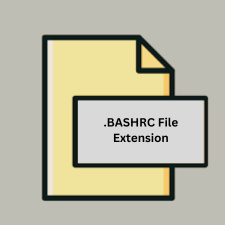.BASHRC File Extension

Bash Non-Interactive Login Shell File
| Developer | The GNU Project |
| Popularity | |
| Category | System Files |
| Format | .BASHRC |
| Cross Platform | Update Soon |
What is an BASHRC file?
The .bashrc file is a shell script that is executed whenever a new terminal session is started in a non-login mode. It is used primarily to set up the environment for the user’s shell session, such as defining environment variables, configuring shell settings, and running scripts.
More Information.
The .bashrc file has been a part of the Bash shell since its inception by Brian Fox in 1989. Its initial purpose was to provide a way to customize the user environment for interactive non-login shells. Unlike login shells, which read initialization files like .bash_profile, non-login shells read .bashrc to configure user settings and preferences.
Origin Of This File.
The .bashrc file is associated with the Bash (Bourne Again SHell) command-line interpreter, which is a widely used shell on Unix-like operating systems. The name bash stands for “Bourne Again SHell,” reflecting its role as an improved version of the original Bourne shell (sh).
File Structure Technical Specification.
- File Type: Shell Script
- File Extension:
.bashrc - Structure: Plain text file with shell commands and script code.
- Technical Specification: Contains commands for setting environment variables, defining aliases, customizing the prompt, and executing scripts or functions that should be available in every terminal session.
How to Convert the File?
- Windows:
- Conversion to PowerShell: Windows uses PowerShell or Command Prompt by default, which do not directly use
.bashrc. To convert Bash aliases and functions to PowerShell, you’ll need to adapt the syntax. For example, Bash aliases likealias ll='ls -la'would be converted to PowerShell commands such asSet-Alias ll Get-ChildItem -Force. - Using WSL (Windows Subsystem for Linux): If you are using WSL, the
.bashrcfile can be used directly within the WSL environment. You can edit it using any text editor available in WSL.
- Conversion to PowerShell: Windows uses PowerShell or Command Prompt by default, which do not directly use
- Linux:
- No Conversion Needed: On Linux, the
.bashrcfile is used directly by the Bash shell. There’s no need for conversion; just ensure that the file is correctly configured and placed in the user’s home directory (~/.bashrc).
- No Conversion Needed: On Linux, the
- macOS:
- Conversion to Zsh: macOS Catalina and later use Zsh as the default shell instead of Bash. To convert
.bashrcconfigurations for Zsh, you’ll need to transfer them to.zshrc. Most Bash configurations work similarly in Zsh, but some syntax might differ. - Direct Usage: If using Bash on macOS, you can use
.bashrcdirectly. Place it in the user’s home directory and ensure it is loaded by your Bash sessions.
- Conversion to Zsh: macOS Catalina and later use Zsh as the default shell instead of Bash. To convert
- Android:
- Using Termux: If using Termux, a terminal emulator for Android, you can use
.bashrcwithin Termux. Place the file in Termux’s home directory (~/.bashrc). Ensure Termux is configured to source this file by adding the appropriate command to your Termux startup scripts if needed. - No Native Support: Android does not natively use Bash or
.bashrc, so this applies specifically to environments like Termux.
- Using Termux: If using Termux, a terminal emulator for Android, you can use
- iOS:
- Limited Unix Support: iOS does not natively support Bash or
.bashrc. To use Unix-like environments on iOS (e.g., via jailbreaking or using apps like iSH), you would need to adapt any.bashrcconfigurations to fit the specific shell environment provided by these apps. - Adaptation: If you are using a Unix-like environment on iOS, you might need to adapt
.bashrcconfigurations to the syntax and capabilities of that environment.
- Limited Unix Support: iOS does not natively support Bash or
- Others:
- Other Unix-like Systems: For other Unix-like systems,
.bashrccan usually be used directly if they use Bash as the default shell. If using a different shell (like Zsh or Fish), you’ll need to adapt the configurations to the syntax of those shells.
- Other Unix-like Systems: For other Unix-like systems,
Advantages And Disadvantages.
Advantages:
- Customization: Allows users to personalize their shell environment, making repetitive tasks easier with aliases and custom functions.
- Consistency: Ensures that certain settings and preferences are automatically applied in every new terminal session.
- Efficiency: Helps in automating the setup of the shell environment, which can speed up workflow.
Disadvantages:
- Complexity: Can become cluttered and complex if not managed properly, leading to potential errors or conflicts.
- Performance Impact: Large or complex
.bashrcfiles might slow down the start-up time of new terminal sessions. - Compatibility: Changes in
.bashrcmight affect only non-login shells, which might lead to inconsistencies if not synchronized with other initialization files like.bash_profile.
How to Open BASHRC?
Open In Windows
Windows does not natively use .bashrc, but you can open and edit it using text editors like Notepad++ or Visual Studio Code. In environments like WSL (Windows Subsystem for Linux), you can use typical Linux commands to edit it.
Open In Linux
Open In Linux: On Linux systems, you can open and edit the .bashrc file using text editors like nano, vim, or gedit.
Open In MAC
Open In MAC: macOS, being Unix-based, also uses .bashrc. You can open and edit it with text editors like nano, vim, or TextEdit.
Open In Android
On Android, accessing and editing .bashrc would typically require a terminal emulator app with root access or a file manager that supports viewing hidden files. Use text editors available in those environments.
Open In IOS
iOS does not natively support Bash or .bashrc files. You would need a terminal application with a Unix-like environment, such as through jailbreaking or using apps like iSH, which provide limited Unix functionality.
Open in Others
In other Unix-like systems or environments with Bash, the .bashrc file can be opened with any standard text editor available in those environments.











